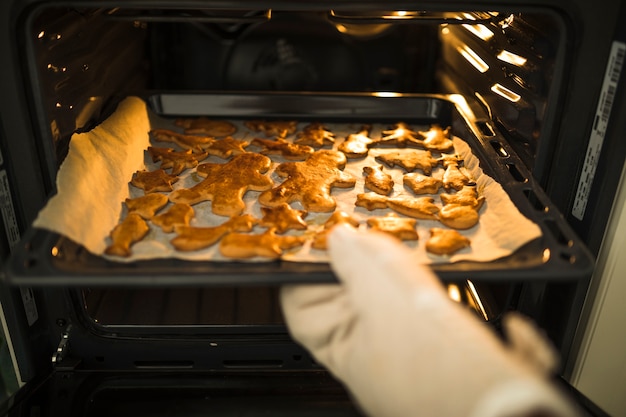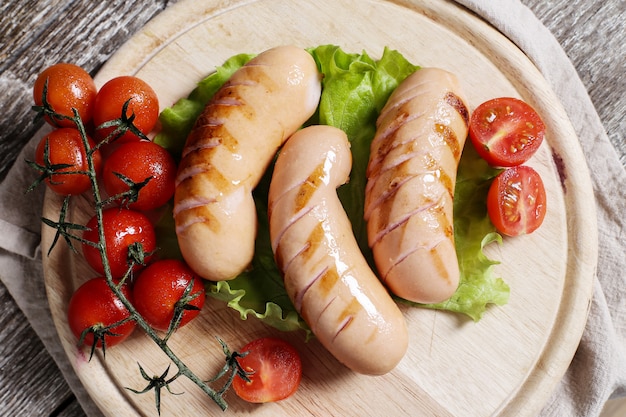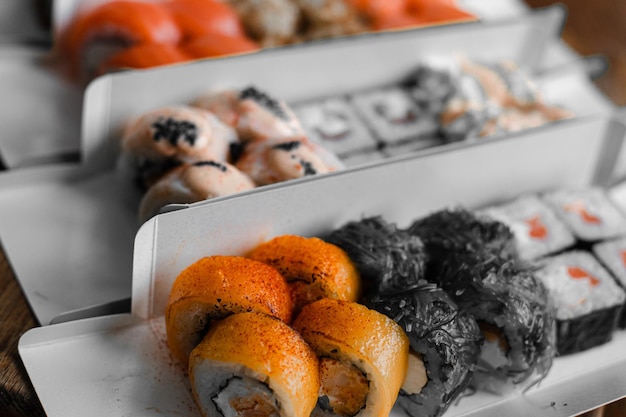As a self-proclaimed sausage aficionado, I've spent countless hours perfecting my oven-baked sausage technique. It's been a delightful journey, driven by a deep desire to elevate these humble meaty tubes into culinary masterpieces. From those early attempts where sausages emerged a tad underdone, to the glorious moments of juicy perfection, every bite has been a lesson learned.
This isn't just about achieving that crispy skin, though that's definitely a crucial element. It's about unlocking the full flavour potential of each sausage, whether it's a traditional pork banger, a spicy chorizo, or a flavour-packed italian sausage. With the right approach, you can achieve that delightful combination of succulent meat and a satisfyingly crisp exterior.
So, grab a comfy chair, brew a cuppa, and let me share my hard-earned knowledge. It's time to elevate your sausage game, and I'm here to guide you every step of the way.
(Part 1) Setting the Stage: Understanding Your Sausage

Before we even think about the oven, it's vital to get acquainted with our star ingredient. Every sausage is unique, with its own personality and cooking requirements. Just like you wouldn't cook a steak the same way you'd cook a chicken breast, each sausage deserves its own approach.
types of sausages
There's a whole world of sausages out there, each with its own character and quirks. Let's break down some of the most common types:
- pork sausage: The classic, versatile sausage. Usually made with ground pork, herbs, and spices. Think British bangers, Cumberland sausages, or American breakfast sausage. They're often seasoned with sage, pepper, and other classic spices, and can be found in various forms, from mild to spicy.
- Chorizo: A Spanish sausage known for its fiery flavour and bright red colour. Typically made with pork, paprika, garlic, and other spices. It can be either sweet or spicy, and adds a burst of flavour to any dish.
- Italian Sausage: This one comes in various flavours, often featuring fennel, garlic, and red pepper flakes. From mild to spicy, Italian sausage is a staple in many dishes, from pasta sauces to sandwiches.
- Bratwurst: A german sausage, usually made with pork and beef, often seasoned with ginger and caraway. It's known for its juicy texture and subtly sweet flavour, often grilled or pan-fried and served with sauerkraut.
- Chicken Sausage: A lighter alternative, made with ground chicken and various seasonings. It's a popular choice for those looking for a less-fatty option, and often comes in flavours like lemon herb, apple sage, or spicy chorizo.
Beyond the basic types, you'll find countless regional variations and specialty sausages. Don't be afraid to experiment and discover your favourites! There's a whole world of flavour waiting to be explored.
Key Factors to Consider
Once you've chosen your sausage, there are a few key factors to consider before you start cooking:
- Size: Small sausages will cook faster than large ones. This is due to their smaller surface area and the fact that they heat up more quickly.
- Thickness: Thick sausages will need a longer cooking time than thin ones. Thicker sausages have more meat to cook through, so they need more time in the oven to reach the desired internal temperature.
- Meat Content: Sausages with a higher meat content will tend to be denser and require more time in the oven. This is because the meat needs more time to cook thoroughly and release its juices.
- Casing: natural casings (made from animal intestines) are more porous and tend to allow the sausage to cook more evenly. artificial casings can be more challenging to get a good crisp on, but they do offer a more uniform shape.
Understanding these factors will help you adjust your cooking times and techniques for optimal results. Remember, the goal is to achieve that perfectly cooked sausage: juicy, flavorful, and with a satisfyingly crisp exterior.
(Part 2) The Oven: Your Sausage's New Home

Now that you understand your sausage, it's time to turn our attention to the oven, the stage upon which your sausage will shine. It's not just about throwing them in and hoping for the best, there's a bit of artistry to oven-baked sausage success.
Preheat, Preheat, Preheat!
This might seem like a basic step, but it's essential for ensuring even cooking. A preheated oven ensures that the sausage cooks through at the same pace, preventing any cold spots or uneven browning. Imagine a symphony, where all the instruments come together in perfect harmony. A preheated oven ensures that each sausage "plays" its part in the symphony of flavours.
The Right Temperature
The ideal oven temperature for sausages is around 350°F (175°C). This temperature allows the sausage to cook thoroughly without drying out. Think of it as a gentle embrace, allowing the sausage to release its flavours and juices without being subjected to extreme heat.
Baking Sheet or roasting pan?
Choosing the right baking vessel can make all the difference. A baking sheet offers excellent airflow, promoting even browning. However, a roasting pan can be beneficial for sausages that release a lot of fat during cooking, as it catches the drippings and prevents them from burning. If you're cooking sausages with a high fat content, a roasting pan is the way to go.
Space is Key
Give your sausages some breathing room! Don't overcrowd the baking sheet or roasting pan, as this can lead to uneven cooking and steaming rather than browning. Each sausage deserves its own space to breathe and develop that beautiful golden crust. Imagine a crowded concert; you wouldn't be able to hear each instrument clearly. The same applies to sausages; give them space and they'll sing their flavourful song.
(Part 3) The Art of Sausage Placement

Now, the moment of truth: positioning your sausages for the perfect oven experience. This isn't just about haphazardly throwing them on the tray, there's a method to the madness, and it all comes down to ensuring even cooking and a beautiful, crispy finish.
Single Layer for Evenness
Arrange your sausages in a single layer on the baking sheet or in the roasting pan. This allows for even heat distribution, ensuring that each sausage cooks evenly. Think of it as a perfectly choreographed dance, where each sausage moves with grace and precision.
Leaving Space for Air Circulation
Ensure there's adequate space between the sausages to allow for proper air circulation. This helps prevent steam buildup and promotes a crispy, golden brown exterior. Just like a well-ventilated room, sausages need space to breathe and develop that desirable crispness.
Think About the Rack
If you're using a baking sheet, consider placing it on a middle rack in your oven. This helps ensure that the heat is distributed evenly around the sausages. Think of it as finding the sweet spot in the oven, where the heat is just right for those sausages to shine.
(Part 4) The Time is Now: Cooking Your Sausages
The anticipation builds! It's finally time to slip those beauties into the oven. It's a moment of excitement, knowing that soon you'll be enjoying the fruits of your labour.
Estimating Cooking Time
The cooking time for sausages can vary depending on their size, thickness, and meat content. As a general rule of thumb:
| Sausage Type | Average Cooking Time |
|---|---|
| Small, Thin Sausages | 15-20 minutes |
| Medium, Thick Sausages | 20-25 minutes |
| Large, Thick Sausages | 25-30 minutes |
Remember: these are just estimates! Keep a close eye on your sausages throughout the cooking process. It's better to err on the side of caution and check them a bit early rather than risk overcooking.
The Internal Temperature Check
For the most reliable way to determine doneness, use a meat thermometer. Sausages should reach an internal temperature of 160°F (71°C) for safety. A meat thermometer is your best friend in the kitchen, ensuring that your sausages are cooked through and safe to eat.
The Visual Cue
While a thermometer is the most accurate method, you can also rely on visual cues. Look for sausages that have a golden brown, slightly crispy exterior. They should also be firm to the touch and have a slight bounce.
(Part 5) The Golden Touch: Achieving Crispness
Who doesn't love that satisfying crunch of a perfectly crispy sausage? Let's unlock the secrets to achieving that golden, crispy perfection. It's a culinary quest for the senses, where texture plays a crucial role alongside flavour.
The Broil Boost
For an extra touch of crispness, consider a quick broil at the end of cooking. Place your sausages under the broiler for a minute or two, watching closely to prevent burning. The broiler is your secret weapon for achieving that extra level of crispness, turning those sausages into a golden, crackling delight.
The Flip Factor
Halfway through cooking, gently flip the sausages over to ensure even browning on both sides. This is particularly important if your sausages are on a baking sheet. Think of it as giving your sausages a little dance, ensuring that each side gets its turn in the spotlight.
The No-Fuss Approach
If you prefer a simpler approach, simply ensure adequate spacing between the sausages and allow them to bake undisturbed. The air circulation will help them crisp up nicely. Sometimes, less is more. Give your sausages the space they need, and let the oven work its magic.
(Part 6) The Sausage Symphony: Flavour Enhancements
Now, let's add some extra layers of flavour to our sausage masterpiece! This is where your creativity and culinary flair can really shine through.
Glazing for Shine and Savour
A glaze can transform your sausages, adding a sweet, sticky, and savoury dimension. Popular options include:
- honey mustard glaze: A classic combination of sweetness and tang. The honey adds a rich sweetness, while the mustard provides a sharp, tangy kick.
- Maple Syrup Glaze: Adds a touch of maple sweetness. The maple syrup provides a warm, delicate sweetness that pairs well with both pork and chicken sausages.
- bbq sauce Glaze: A smoky and tangy addition. The BBQ sauce adds a depth of flavour, with smoky notes and a tangy edge.
Brush the glaze onto your sausages during the last 10-15 minutes of cooking, allowing it to caramelize and create a beautiful finish. The glaze will create a beautiful, glossy exterior, while infusing the sausages with even more flavour.
Herb and Spice Infusions
Want to add a touch of your own personality? Try infusing your sausages with your favourite herbs and spices during the cooking process. Think of it as adding your own unique signature to your culinary masterpiece.
- Rosemary and Thyme: Classic herbs that pair well with pork sausages. These herbs add a touch of earthy, herbaceous flavour, complementing the pork beautifully.
- Garlic and Chilli Flakes: Adds a spicy kick. For those who like a bit of heat, garlic and chilli flakes provide a punch of flavour, adding a touch of warmth and spice.
- Paprika and Cumin: For a touch of warmth and earthiness. Paprika and cumin add a depth of flavour, with a warm, earthy aroma and a subtle spice.
Simply sprinkle your chosen herbs and spices over the sausages before baking. They will infuse the sausages with their unique flavours during the cooking process.
(Part 7) sausage sides: Perfect Pairings
No sausage adventure is complete without the right accompaniments! The perfect side dish can elevate your sausage experience to a whole new level.
Classic Combos
Sausages are incredibly versatile, pairing well with a wide range of side dishes. Here are some classic combinations:
- mashed potatoes: A creamy and comforting companion. Mashed potatoes provide a creamy, comforting base that balances the richness of the sausage.
- Roasted Vegetables: Adds a burst of colour and flavour. Roasted vegetables bring a vibrant touch, adding a medley of textures and flavours to complement the sausage.
- Green Salad: A refreshing counterpoint to the richness of the sausage. A green salad provides a refreshing contrast, cleansing the palate and balancing the richness of the sausage.
Creative Accompaniments
For those who enjoy venturing beyond the traditional, here are some inspired pairings:
- Apple and Onion Slaw: A sweet and tangy addition that complements both pork and chicken sausages. The sweetness of the apple and the tang of the onion create a delightful counterpoint to the savoury sausage.
- Polenta: A creamy Italian dish that works well with Italian sausages. Polenta provides a creamy, comforting base for Italian sausages, enhancing their flavour and creating a satisfyingly hearty meal.
- Couscous: A light and fluffy grain that complements spicy sausages. Couscous offers a light and fluffy texture that complements the spiciness of the sausage, providing a balance of flavours and textures.
(Part 8) The After-Bake: Rest and Serve
After those gorgeous sausages have reached their peak in the oven, let's give them a well-deserved rest. Just like a marathon runner, sausages need a chance to recover and settle before being enjoyed.
Rest Time
Allow the sausages to rest for a few minutes after baking. This allows the juices to redistribute, ensuring that they are tender and juicy when you slice into them. Think of it as a moment of relaxation, allowing the flavours to settle and meld together for a truly satisfying experience.
Serving Suggestions
Now, it's time to unleash the culinary masterpiece you've created! Here are some serving suggestions:
- sausage rolls: Slice the sausages and serve them in rolls with your favourite condiments. Perfect for a quick and easy meal or a delicious snack.
- Sausage Platter: Create a delightful sausage platter with a variety of sausage types, sides, and dipping sauces. A feast for the eyes and the palate.
- sausage sandwiches: A classic and satisfying option, served on crusty bread or soft buns. A timeless favourite, perfect for a casual meal or a fun gathering.
(Part 9) The Sausage Legacy: Sharing Your Expertise
Now that you've mastered the art of oven-baked sausage, it's time to share your knowledge! Share your wisdom and passion with the world, becoming a sausage ambassador.
Passing the Torch
Embrace the joy of sharing your newfound sausage expertise with friends and family. Help them elevate their culinary game with your tips and tricks. There's nothing more rewarding than helping others discover the joys of perfectly cooked sausages.
Celebrating Sausage Success
Every perfectly cooked sausage is a victory! Celebrate your culinary achievements with gusto and share your triumphs with the world. Don't be shy; share your sausage creations on social media and inspire others to embrace the world of oven-baked sausages.
FAQs
1. Can I cook sausages in the oven with other foods?
Absolutely! Sausages pair well with many oven-baked dishes. You can roast them alongside vegetables, potatoes, or even other proteins. Just be sure to leave enough space between them for even cooking. Think of it as a culinary harmony, where different flavours and textures come together to create a symphony of taste.
2. What if my sausages release a lot of fat while cooking?
No worries! It's perfectly normal for sausages to release some fat. If you're using a baking sheet, simply drain off the excess fat into a separate container. For a roasting pan, the fat will collect in the bottom of the pan. You can use the rendered fat to flavour other dishes, or discard it as you see fit.
3. How do I prevent sausages from drying out in the oven?
The key is to cook them at the right temperature and for the right amount of time. Avoid overcooking, and make sure the oven is preheated to the correct temperature. A bit of moisture, such as a drizzle of water or broth in the bottom of the pan, can also help keep them juicy. Think of it as adding a little touch of hydration, ensuring that those sausages stay plump and juicy.
4. Can I freeze cooked sausages?
Yes! You can freeze cooked sausages for later use. Just allow them to cool completely, then store them in an airtight container or freezer bag. They can be frozen for up to 2-3 months. A great way to have a delicious meal ready in a flash.
5. What are some creative ways to use leftover cooked sausages?
The possibilities are endless! Leftover sausages can be used in salads, sandwiches, pastas, or even stir-fries. They can also be added to soups or stews for a hearty boost of flavour. Don't let those delicious sausages go to waste; get creative and use them in a variety of dishes.
Everyone is watching

Prime Rib Roast Cooking Time Chart: Per Pound Guide
Cooking TipsPrime rib roast. Just the name conjures images of lavish dinners, crackling fires, and hearty laughter. It’s ...

How Long to Bake Potatoes in the Oven (Perfect Every Time)
Cooking TipsBaked potatoes are a staple in my kitchen. They're incredibly versatile, delicious, and surprisingly easy to m...

Perfect Rice Every Time: The Ultimate Guide to Cooking Rice
Cooking TipsAs a self-proclaimed foodie, I've always been a bit obsessed with rice. It's the foundation of countless cuisi...

The Ultimate Guide to Cooking Asparagus: Tips, Techniques, and Recipes
Cooking TipsAsparagus. The mere mention of this spring delicacy conjures up images of vibrant green spears, crisp and burs...

Ultimate Guide to Cooking the Perfect Thanksgiving Turkey
Cooking TipsThanksgiving. Just the word conjures up images of overflowing tables laden with delicious food, the scent of r...
